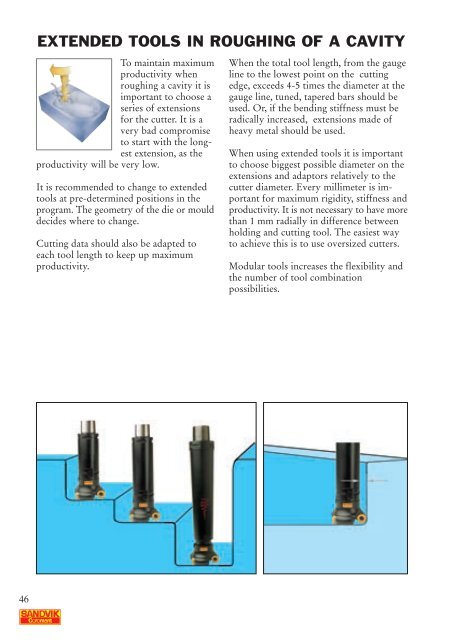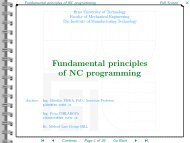Die & Mould Making - CNC - Computer Numerical Control
Die & Mould Making - CNC - Computer Numerical Control
Die & Mould Making - CNC - Computer Numerical Control
You also want an ePaper? Increase the reach of your titles
YUMPU automatically turns print PDFs into web optimized ePapers that Google loves.
46<br />
EXTENDED TOOLS IN ROUGHING OF A CAVITY<br />
To maintain maximum<br />
productivity when<br />
roughing a cavity it is<br />
important to choose a<br />
series of extensions<br />
for the cutter. It is a<br />
very bad compromise<br />
to start with the longest<br />
extension, as the<br />
productivity will be very low.<br />
It is recommended to change to extended<br />
tools at pre-determined positions in the<br />
program. The geometry of the die or mould<br />
decides where to change.<br />
Cutting data should also be adapted to<br />
each tool length to keep up maximum<br />
productivity.<br />
When the total tool length, from the gauge<br />
line to the lowest point on the cutting<br />
edge, exceeds 4-5 times the diameter at the<br />
gauge line, tuned, tapered bars should be<br />
used. Or, if the bending stiffness must be<br />
radically increased, extensions made of<br />
heavy metal should be used.<br />
When using extended tools it is important<br />
to choose biggest possible diameter on the<br />
extensions and adaptors relatively to the<br />
cutter diameter. Every millimeter is important<br />
for maximum rigidity, stiffness and<br />
productivity. It is not necessary to have more<br />
than 1 mm radially in difference between<br />
holding and cutting tool. The easiest way<br />
to achieve this is to use oversized cutters.<br />
Modular tools increases the flexibility and<br />
the number of tool combination<br />
possibilities.



